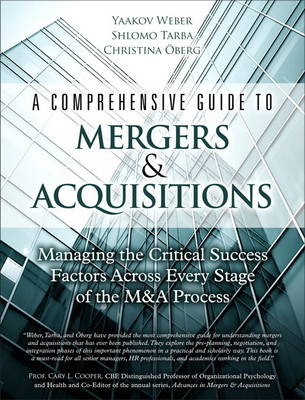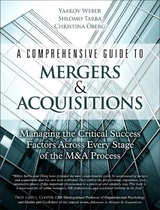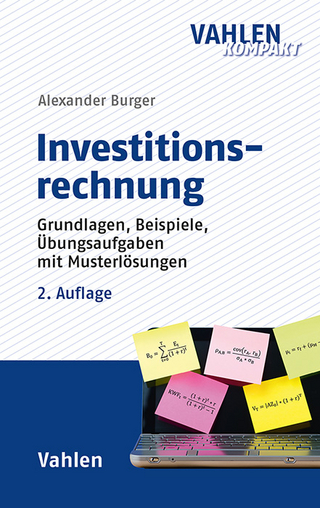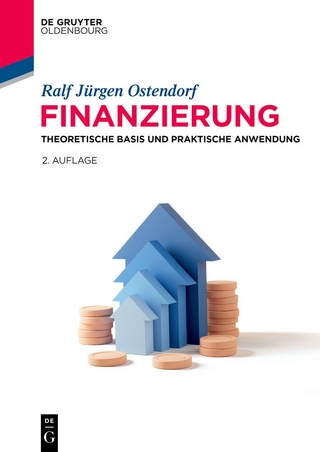
A Comprehensive Guide to Mergers & Acquisitions
Financial Times Prentice Hall (Verlag)
978-0-13-301415-0 (ISBN)
- Titel erscheint in neuer Auflage
- Artikel merken
Yaakov Weber, Ph.D. is a professor of management at the School of Business Administration, College of Management, Rishon Lezion, Israel, and president of the strategic management consulting firm Strategy, Implementation, Results. He has practiced as a strategic management consultant for more than 25 years and has assisted executives of numerous companies in successfully managing various stages of domestic and international mergers and acquisitions, including planning, negotiation, and integration. He lectures at various universities in the United States, Western and Eastern Europe, and China, in graduate schools of business administration as well as executive programs. He has conducted numerous workshops to top executives in many countries. Dr. Weber’s studies have been published in top international academic and practitioner journals, and his papers have received more than 2,000 citations in leading journals and books. He is the winner of the 2010 Outstanding Author Contribution Award. Professor Weber is co-founder and co-president of the EuroMed Research Business Institute (www.emrbi.com), the EuroMed Academy of Business, and the EuroMed Research Centre. EMRBI performs a variety of international academic and business activities (conferences, business research, teaching, training programs, and so on) that involve businesses and consultants in, and related to, the EuroMed region. Shlomo Y. Tarba, Ph.D. is a lecturer in Strategic Management and Global Strategic Partnerships at the Management School, The University of Sheffield, UK. He received his Ph.D. from Ben-Gurion University and master’s degree in biotechnology at the Hebrew University of Jerusalem, Israel. His research papers has been published in journals such as Academy of Management Perspectives, International Studies of Management & Organization, Thunderbird International Business Review, International Journal of Cross- Cultural Management, Human Resource Management Review, Advances in Mergers and Acquisitions, and others. Dr. Tarba has served as a guest editor for the special issues on Strategic Agility at California Management Review; Organizational Ambidexterity at Human Resource Management; Maturing Born-Global Knowledge Intensive Firms at Management International Review; Emotions, Culture, and Stress in the Interorganizational Encounters at International Business Review; and others. He was granted the 2010 Outstanding Author Contribution Award by Emerald Publishing. His consulting experience includes biotechnological and telecom companies, as well as industry associations such as The Israeli Rubber and Plastic Industry Association and The U.S.–Israel Chamber of Commerce. Christina Öberg, Ph.D. is an associate professor at the Department of Industrial Management and Logistics, Lund University. She currently conducts research at the Centre for Innovation and Service Research, University of Exeter. She received her Ph.D. in industrial marketing from Linköping University. She has an industry background in which she held such positions as financial manager and head accountant. Her research interests include mergers and acquisitions, brands and identities, customer relationships, and innovation management. She has previously been published in journals such as Journal of Business Research, Construction Management and Economics, International Journal of Innovation Management, European Journal of Marketing, The Service Industries Journal, Journal of Business-to-Business Marketing, Scandinavian Journal of Management, Thunderbird International Business Review, and Industrial Marketing Management.
Preface xvi
Part I Value Creation Model for Mergers and Acquisitions 1
Chapter 1 The M&A Paradox: Factors of Success and Failure in Mergers and Acquisitions 3
Finance and the Capital Market 5
Strategic Management 7
Organizational Behavior 9
References 11
Chapter 2 An Integrated Model for Value Creation in Mergers and Acquisitions 13
Overview 13
Different Disciplines, Different Stages, No Interrelationships 14
An Integrated Model for Value Creation in M&A 17
Stage I: Planning and Strategic Management 18
1 Strategic Management, Goals, and M&A Strategy 18
2 Searching, Screening, and Selection 19
3 Financial and Strategic Estimate, Including Synergy Analysis and Corporate Culture Differences 19
4 Integration Planning 20
Stage II: Negotiation, Due Diligence, and Agreement 20
1 The Negotiation Processes 20
2 Assessment of Due Diligence 21
Stage III: Integrating the Organizations 22
1 Approaches to Integration, Cultural Differences, and Human Capital Integration 22
2 Leadership and Integration Infrastructure 23
3 Stress and Tension 23
4 Communication Strategy 24
5 Cultural Assessment and Cultural Integration 24
6 Integration Approaches 25
7 Evaluation, Control, and Feedback 26
Conclusion 26
References 27
Chapter 3 Strategic Motives and Considerations 29
Introduction 29
Strategic Motives for an M&A 29
Synergy 30
Market Power 31
Diversification 31
Financial and Tax Issues 32
Valuation Ratio 32
Agency Theory 32
The Strategic Management of M&As as Part of Corporate and
Competitive Strategies 33
References 36
Chapter 4 M&A Strategic Decisions .37
Decision 1: Should the M&A be Part of the Current Strategy? 37
Decision 2: Choice of the Appropriate Partner for the M&A:
Strategic Fit and Post-Merger Integration (PMI) 40
Diversification: Two Main Types of M&As 41
Entering into a New Industry 41
Unrelated Diversification: New Business 42
Related Diversification 43
Joint Ventures 47
Strategic Outsourcing 48
Reference 49
Part II Analysis Tools for Key Success Factors 51
Chapter 5 Synergy Potential and Realization 53
Introduction 53
Sources of Synergies 53
Sharing Resources 54
Knowledge, Skills, and Capabilities Transfer 54
Types of Knowledge 55
Knowledge Transfer Process 56
Issues of Knowledge Transfer 57
Enable Knowledge Transfer 58
Knowledge Transfer in Technology and Innovation-Intensive Acquisitions 59
Knowledge Transfer of General Management Skills and Capabilities 60
Other Benefits of the M&A 60
Analysis of Synergy Potential 61
Horizontal Mergers 61
Vertical Integration 62
Saving on Expenses 63
Assurance of Supply or Demand 64
Improvement of Competitive Advantage 64
Disadvantages of Vertical Integration 65
References 68
Chapter 6 Culture and Cultural Differences Analysis 69
Introduction 69
The Importance and Advantages of Evaluation and Measurement of Differences of Management Culture 70
What Is Organizational Culture? 71
Dimensions of Organizational Culture 72
1 Approach to Innovation and Activity 73
2 Approach to Risk-Taking 73
3 Lateral Interdependence: Horizontal Relationship 73
4 Top Management Contact: Vertical-Hierarchical Contact 74
5 Autonomy and Decision Making 74
6 Approach to Performances 74
7 Approach to Rewards 75
Measurement and Evaluation of Cultural Differences 76
Using Cultural Differences Analysis in All M&A Stages 79
Conclusion 81
References 81
Chapter 7 Searching, Screening, and Selection of M&A Alternatives 83
The Process of Search and Identification 83
Establishment of a Business Development Unit 84
Determination of Criteria for the Search and Screening 86
Determination of Search Strategy 92
Independent Search Plan 92
Search through Agents 93
Approaching the Target Company 94
Friendly Approach 95
Making-the-Most-of-the-Opportunity Approach 95
Hostile Approach 95
References 97
Part III Negotiation 99
Chapter 8 Selection of Target and Negotiation Process 101
Choice of Partner 102
Sources of Information 105
Evaluation of the Target 107
Price Valuation 109
Negotiation 110
References 123
Chapter 9 Extended Due Diligence Examination and Summative Evaluation for M&As 127
The Process and Goals of Due Diligence 127
Extension of the Due Diligence Examination 128
Topics for the Examination of Due Diligence 129
Legal Topics 130
Business and Operational Topics 132
Due Diligence Examination of Organizational Culture 136
Evaluations Regarding Synergy Potential and Realization 137
Chapter 10 Agreements 141
Letter of Intention (LOI) or Memorandum of Understanding (MOU) 141
The Acquisition Agreement 145
How to Be Helped by Lawyers 147
Part IV Post-Merger Integration and Implementation 149
Chapter 11 Management of Culture Clash 151
Culture Clash Evolution and Stages 151
I Perceived Differences 152
II Magnified Differences 152
III Stereotypes 153
IV Putdowns 153
Managing the Culture Clash 153
Planning Stage 153
Negotiation Stage 154
PMI Stage 154
References 156
Chapter 12 Communication 157
Introduction 157
Communications with All Stakeholders 157
Communicating with External Parties 158
Communicating with Internal Parties 160
Managing Communication 163
Methods and Channels of Communication 165
References 166
Chapter 13 Integration Approaches 167
Introduction 167
Integration and Culture Clash 167
Trade-Off Between Integration and Synergy Exploitation 168
Cultural Differences and Levels of Integration 169
M&A Performance and Integration Approaches 170
A Framework for Integration Approach Choice 172
References 174
Chapter 14 Human Capital Issues and Practices 177
The Human Factor 177
The Effects of Cultural Differences and Level of Integration on
Behavior in an M&A 178
Culture Clash Effects on Behavior 178
Level of Integration Effects on Behavior 179
Nature of Contact 180
HR Issues, Implications, and Actions at M&A Stages 181
Planning Stage 182
Negotiation Stage 183
Implementation Stage 184
HR Practices 185
Training 186
References 187
Chapter 15 M&A Leadership 189
Introduction 189
Leadership Challenges During an M&A 189
The Roles and Skills of Leadership in an M&A 190
Leadership Teams 191
Leadership Skills 192
References 198
Chapter 16 Trust Formation and Change in M&A 201
Introduction 201
Trust in the M&A 201
The Nature of Trust 202
Prior Relationships 203
Negotiation Process 204
Partner Abilities and Competencies 204
Cultural Differences 204
Leadership 204
Process Dynamic and Learning 205
Communication 205
Autonomy Removal 206
Perceived Benefits 206
Consequences of the M&A and Trust 206
References 207
Index 209
| Erscheint lt. Verlag | 23.1.2014 |
|---|---|
| Verlagsort | Upper Saddle River |
| Sprache | englisch |
| Maße | 182 x 239 mm |
| Gewicht | 520 g |
| Themenwelt | Mathematik / Informatik ► Informatik |
| Wirtschaft ► Betriebswirtschaft / Management ► Finanzierung | |
| Wirtschaft ► Betriebswirtschaft / Management ► Planung / Organisation | |
| Wirtschaft ► Betriebswirtschaft / Management ► Rechnungswesen / Bilanzen | |
| ISBN-10 | 0-13-301415-0 / 0133014150 |
| ISBN-13 | 978-0-13-301415-0 / 9780133014150 |
| Zustand | Neuware |
| Haben Sie eine Frage zum Produkt? |
aus dem Bereich



